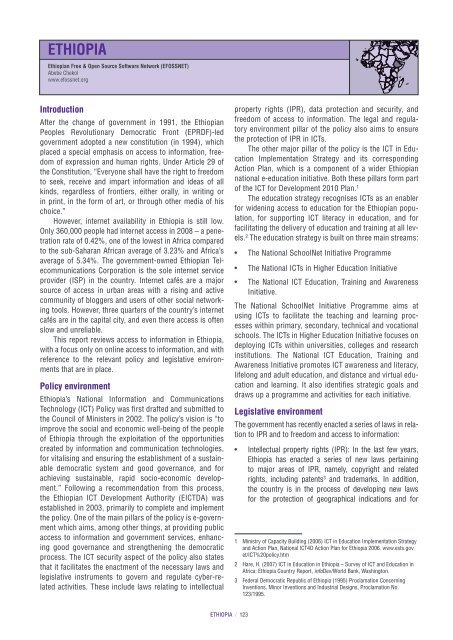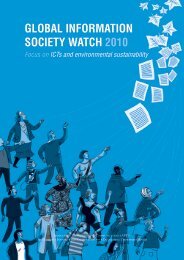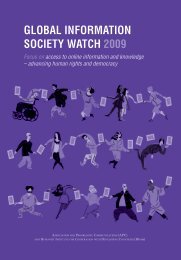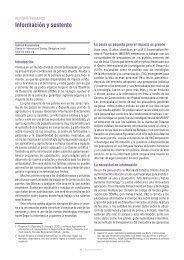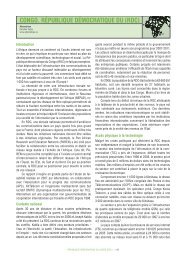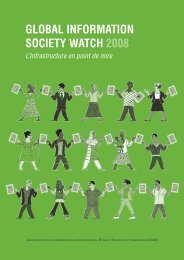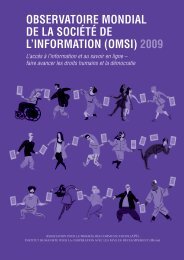ETHIOPIA - Global Information Society Watch
ETHIOPIA - Global Information Society Watch
ETHIOPIA - Global Information Society Watch
You also want an ePaper? Increase the reach of your titles
YUMPU automatically turns print PDFs into web optimized ePapers that Google loves.
Ethiopia<br />
Ethiopian Free & Open Source Software Network (EFOSSNET)<br />
Abebe Chekol<br />
www.efossnet.org<br />
Introduction<br />
After the change of government in 1991, the Ethiopian<br />
Peoples Revolutionary Democratic Front (EPRDF)-led<br />
government adopted a new constitution (in 1994), which<br />
placed a special emphasis on access to information, freedom<br />
of expression and human rights. Under Article 29 of<br />
the Constitution, “Everyone shall have the right to freedom<br />
to seek, receive and impart information and ideas of all<br />
kinds, regardless of frontiers, either orally, in writing or<br />
in print, in the form of art, or through other media of his<br />
choice.”<br />
However, internet availability in Ethiopia is still low.<br />
Only 360,000 people had internet access in 2008 – a penetration<br />
rate of 0.42%, one of the lowest in Africa compared<br />
to the sub-Saharan African average of 3.23% and Africa’s<br />
average of 5.34%. The government-owned Ethiopian Telecommunications<br />
Corporation is the sole internet service<br />
provider (ISP) in the country. Internet cafés are a major<br />
source of access in urban areas with a rising and active<br />
community of bloggers and users of other social networking<br />
tools. However, three quarters of the country’s internet<br />
cafés are in the capital city, and even there access is often<br />
slow and unreliable.<br />
This report reviews access to information in Ethiopia,<br />
with a focus only on online access to information, and with<br />
reference to the relevant policy and legislative environments<br />
that are in place.<br />
Policy environment<br />
Ethiopia’s National <strong>Information</strong> and Communications<br />
Technology (ICT) Policy was first drafted and submitted to<br />
the Council of Ministers in 2002. The policy’s vision is “to<br />
improve the social and economic well-being of the people<br />
of Ethiopia through the exploitation of the opportunities<br />
created by information and communication technologies,<br />
for vitalising and ensuring the establishment of a sustainable<br />
democratic system and good governance, and for<br />
achieving sustainable, rapid socio-economic development.”<br />
Following a recommendation from this process,<br />
the Ethiopian ICT Development Authority (EICTDA) was<br />
established in 2003, primarily to complete and implement<br />
the policy. One of the main pillars of the policy is e‐government<br />
which aims, among other things, at providing public<br />
access to information and government services, enhancing<br />
good governance and strengthening the democratic<br />
process. The ICT security aspect of the policy also states<br />
that it facilitates the enactment of the necessary laws and<br />
legislative instruments to govern and regulate cyber-related<br />
activities. These include laws relating to intellectual<br />
property rights (IPR), data protection and security, and<br />
freedom of access to information. The legal and regulatory<br />
environment pillar of the policy also aims to ensure<br />
the protection of IPR in ICTs.<br />
The other major pillar of the policy is the ICT in Education<br />
Implementation Strategy and its corresponding<br />
Action Plan, which is a component of a wider Ethiopian<br />
national e‐education initiative. Both these pillars form part<br />
of the ICT for Development 2010 Plan. 1<br />
The education strategy recognises ICTs as an enabler<br />
for widening access to education for the Ethiopian population,<br />
for supporting ICT literacy in education, and for<br />
facilitating the delivery of education and training at all levels.<br />
2 The education strategy is built on three main streams:<br />
• The National SchoolNet Initiative Programme<br />
• The National ICTs in Higher Education Initiative<br />
• The National ICT Education, Training and Awareness<br />
Initiative.<br />
The National SchoolNet Initiative Programme aims at<br />
using ICTs to facilitate the teaching and learning processes<br />
within primary, secondary, technical and vocational<br />
schools. The ICTs in Higher Education Initiative focuses on<br />
deploying ICTs within universities, colleges and research<br />
institutions. The National ICT Education, Training and<br />
Awareness Initiative promotes ICT awareness and literacy,<br />
lifelong and adult education, and distance and virtual education<br />
and learning. It also identifies strategic goals and<br />
draws up a programme and activities for each initiative.<br />
Legislative environment<br />
The government has recently enacted a series of laws in relation<br />
to IPR and to freedom and access to information:<br />
• Intellectual property rights (IPR): In the last few years,<br />
Ethiopia has enacted a series of new laws pertaining<br />
to major areas of IPR, namely, copyright and related<br />
rights, including patents 3 and trademarks. In addition,<br />
the country is in the process of developing new laws<br />
for the protection of geographical indications and for<br />
1 Ministry of Capacity Building (2006) ICT in Education Implementation Strategy<br />
and Action Plan, National ICT4D Action Plan for Ethiopia 2006. www.ests.gov.<br />
et/ICT%20policy.htm<br />
2 Hare, H. (2007) ICT in Education in Ethiopia – Survey of ICT and Education in<br />
Africa: Ethiopia Country Report, infoDev/World Bank, Washington.<br />
3 Federal Democratic Republic of Ethiopia (1995) Proclamation Concerning<br />
Inventions, Minor Inventions and Industrial Designs, Proclamation No.<br />
123/1995.<br />
ethiopia / 123
“undisclosed information”. 4 IPR is receiving government<br />
interest and attention primarily through the efforts of the<br />
Ethiopian Intellectual Property Office (EIPO). Until the formation<br />
of the EIPO 5 in 2003, responsibility for and control<br />
over the various areas of intellectual property were handled<br />
by different, unrelated government agencies, none of<br />
them with the proper authority in the field of IPR.<br />
• Freedom of the Mass Media and Access to <strong>Information</strong><br />
Proclamation (Proclamation No. 590/2008): This<br />
proclamation, in its Article 4 on Freedom of Mass Media,<br />
proclaims that “[f]reedom of the mass media is<br />
constitutionally guaranteed. Censorship in any form is<br />
prohibited.” Article 12 of this proclamation on the “Right<br />
of Access to <strong>Information</strong>” states that “[a]ll persons have<br />
the right to seek, obtain and communicate any information<br />
held by public bodies, except as expressly provided<br />
for by this Proclamation.” As stated in this article, this<br />
right includes access to information from any public<br />
body by means of “diskettes, floppies or any other<br />
electronic mode or through print-outs where such information<br />
is stored in a computer or in any other device.” 6<br />
• Voice over internet protocol (VoIP) users continued to<br />
grow, fuelled primarily by the demand for lower cost<br />
services and its integration into a number of new services<br />
offered on IP (internet protocol) networks. As in<br />
many African countries, 7 Ethiopia bans VoIP services.<br />
According to the amended Telecommunication Law of<br />
2002, Sub-Article 3 of Article 24 of the Proclamation<br />
states that “the use or provision of voice communication<br />
or fax services through the Internet are prohibited.” 8<br />
Key issues<br />
Like many other countries in Africa, the spread and use<br />
of ICTs in Ethiopia is a function of a number of factors including<br />
infrastructure, access and a supportive enabling<br />
environment (i.e., the legal and regulatory environment). ICT<br />
infrastructure, apart from its operation and maintenance, involves<br />
considering non-ICT infrastructure such as transport<br />
4 Booz Allen Hamilton (2007) Ethiopia Commercial Law & Institutional Reform<br />
and Trade Diagnostic, USAID. “Geographical indication is an aspect of<br />
industrial property which refers to a country or to a place as being the country<br />
or place of origin of that product. Under Articles 1(2) and 10 of the Paris<br />
Convention for the Protection of Industrial Property, geographical indications<br />
are covered as an element of IPRs. They are also covered under Articles 22<br />
to 24 of the Trade Related Aspects of Intellectual Property Rights (TRIPs)<br />
Agreement. Undisclosed information is also one category of ‘intellectual<br />
property’ as defined in Article 1.2 of TRIPs. Such information has also been<br />
referred to as ‘trade secrets’ or ‘know-how’, and covers any secret information<br />
of commercial value.” Source: Department of Industrial Policy and Promotions,<br />
Ministry of Commerce and Industry of the Government of India website: www.<br />
patentoffice.nic.in/ipr/gi/geo_ind.htm<br />
5 Federal Democratic Republic of Ethiopia (2003) Ethiopian Intellectual Property<br />
Office Establishment Proclamation, Proclamation No. 320/2003.<br />
6 Federal Democratic Republic of Ethiopia (2008) Freedom of the Mass Media<br />
and Access to <strong>Information</strong> Proclamation, Proclamation No. 590/2008.<br />
7 United Nations Economic Commission for Africa (2009) Implementing the<br />
World Summit on the <strong>Information</strong> <strong>Society</strong> Action Lines: Analysis of Country<br />
Reports, UNECA, Addis Ababa.<br />
8 Federal Democratic Republic of Ethiopia (2002) Telecommunications<br />
(Amendment) Proclamation, Proclamation No. 281/2002.<br />
and electricity. Access is determined by things like public<br />
access facilities, the existence of relevant content, and adequate<br />
capacity to use ICTs at different levels. The legal and<br />
regulatory enabling environment is an important aspect, not<br />
only with regard to the specific ICT regulatory framework,<br />
but also the overall policy framework that promotes sound<br />
economic and political governance.<br />
Increasing convergence across different technologies, in<br />
which the internet is becoming the common platform for voice,<br />
data and broadcast information, offers potential for cutting the<br />
costs of network deployment, along with providing new synergies<br />
between products and media.. The internet is not only<br />
a mechanism for the dissemination of information; it is also<br />
a broadcasting system, a peer-to-peer platform, and a marketplace.<br />
Similarly, mobile phones are not only used for voice<br />
services; they also facilitate internet access, data collection and<br />
even financial services. Therefore, increasing convergence in<br />
technologies is offering the flexibility for people to get access<br />
to information for their socioeconomic development whether<br />
through the internet or through the use of mobile phones.<br />
The Ethiopian Telecommunications Corporation (ETC)<br />
began providing mobile internet services using general<br />
packet radio service (GPRS) in July 2009. GPRS is aimed at<br />
adding internet services on the mobile phone for users. ETC<br />
announced that the service users have to pay one cent per<br />
10 kilobytes of web use. Given the mobile rate of penetration<br />
of 3.72%, this service still benefits a limited number of people<br />
with access to the services. However, the government’s<br />
plan in laying 10,000 kilometres of optical fibre network<br />
throughout the country, 4,000 kilometres of which is already<br />
completed, will significantly improve access and connectivity<br />
in Ethiopia.<br />
Looking at the growth of access, there is an overall<br />
trend in Ethiopia toward use of wireless technologies. This<br />
explains the relatively slow growth in fixed lines, which remain<br />
at 1.07 per 100 inhabitants (2008). This together with<br />
high tariffs relative to income levels, and low domestic personal<br />
computer (PC) access – a total of 532,000 home PCs<br />
(2007) – has lead to relatively slow rates of internet and<br />
broadband uptake in the country. By the end of 2008 there<br />
were only 40,034 internet subscribers, with around 360,000<br />
estimated internet users, which is 0.42 per 100 inhabitants.<br />
This is an insignificant number when considering a population<br />
of over 83 million. However, the situation is changing<br />
quite rapidly in urban areas with the recent introduction of<br />
wireless broadband and the increased use of the internet on<br />
mobile phones. Nevertheless, with the low level of connectivity,<br />
public access facilities are the most important means<br />
of providing communities with access to information.<br />
A number of grey-market operators provide VoIP services<br />
in Addis Ababa, and a few other cities outside of the<br />
capital. There are periodic shutdowns of operators whose<br />
equipment is confiscated. 9 However, today a growing<br />
9 Cohen, T. and Southwood, R. (2004) An Overview of VoIP Regulation in<br />
Africa: Policy Responses and Proposals, prepared for the Commonwealth<br />
Telecommunications Organisation (CTO), London.<br />
124 / <strong>Global</strong> <strong>Information</strong> <strong>Society</strong> <strong>Watch</strong>
number of countries have or are about to legalise VoIP. As<br />
a result Ethiopia might move in this direction as part of the<br />
privatisation process.<br />
In relation to access, the other key area is the availability<br />
of relevant content. With well over half of the websites in the<br />
world in English 10 and with only 42% of the adult population<br />
able to read and write in Ethiopia, language skills and literacy<br />
are key issues that need to be considered in discussions on<br />
access to information online. Lagging internet applications<br />
and content in Ethiopia have also retarded the development<br />
of online access to information. However, when some of the<br />
initiatives in the ICT for education strategy are implemented<br />
in full, it is expected that access to online information will<br />
be widespread.<br />
Access is also determined with the existence of adequate<br />
capacity in using ICTs at different levels. In this<br />
regard, a recent United Nations Economic Commission<br />
for Africa (UNECA) 11 survey on the implementation of the<br />
World Summit on the <strong>Information</strong> <strong>Society</strong> (WSIS) action<br />
lines in Africa reveals that, like many countries, Ethiopia<br />
does not have sufficient digital literacy for supporting<br />
digital-economy and knowledge-economy activities. However,<br />
ICT training is becoming more and more important as<br />
the demand for computer literacy and knowledge of data<br />
processing and application skills is increasing. ICT training<br />
is the second most important activity of ICT firms in<br />
Ethiopia. 12 Furthermore, through the National SchoolNet<br />
Initiative Programme, all high schools have been provided<br />
with computers, which will contribute to the digital literacy<br />
in the country. Over 30 government and private universities<br />
and colleges are also offering ICT training programmes at<br />
various levels.<br />
The legal and regulatory environment is the other key<br />
area in the discussion on access to information online. There<br />
has been increasing concern in the last ten years about<br />
damaging internet content. The kinds of content provoking<br />
concern have varied greatly, and ranged from political<br />
speeches to material promoting or inciting racial hatred, violence<br />
or terrorism (including bomb-making instructions), to<br />
pornographic material, including child pornography. 13 Consequently,<br />
many governments around the world have sought<br />
to address the problem by stating that what is illegal under<br />
general laws applies to online content.<br />
Some of the arguments that many put forward for<br />
controlling internet content include: 14 the internet is fundamentally<br />
just another communications network; there is<br />
10 www.itu.int/ITU-D/ICTEYE/Indicators/Indicators.aspx<br />
11 United Nations Economic Commission for Africa (2009) op. cit.<br />
12 EICTDA (Ethiopian ICT Development Agency) (2009) ICT Assisted Development<br />
Project Monitoring and Evaluation Report on ICT Laws Enacted and ICT<br />
Business Status in Major Towns of Ethiopia (2008), EICTDA, Addis Ababa.<br />
13 Wikibooks (2008) Legal and Regulatory Issues in the <strong>Information</strong> Economy/<br />
Censorship or Content Regulation. Retrieved 5 July 2009 from en.wikibooks.<br />
org/wiki/Legal_and_Regulatory_Issues_in_the_<strong>Information</strong>_Economy/<br />
Censorship_or_Content_Regulation<br />
14 Darlington, R. (2009) How the Internet could be regulated. www.<br />
rogerdarlington.co.uk/Internetregulation.html<br />
a range of problematic content on the internet which we<br />
cannot ignore; the internet is now a mass media and needs<br />
regulation like any other media; and most users want some<br />
form of content regulation or control. Others argue against<br />
internet content regulation saying that the internet was created<br />
as a totally different kind of network and should be<br />
a “free” space; the internet is a “pull”, not a “push” communications<br />
network (in that users actively select content<br />
to download); the internet is a global network that cannot<br />
simply be regulated; it is a technically complex and evolving<br />
network that can never be regulated; and any form of regulation<br />
is flawed and imperfect.<br />
Internet penetration in sub-Saharan Africa in general,<br />
and in Ethiopia in particular, lags behind much of the rest<br />
of the world due to a variety of economic, political and infrastructural<br />
reasons. Internet regulation in Ethiopia, as a<br />
result, primarily focuses on infrastructure and access-related<br />
issues rather than on content regulation, although there<br />
are moves to broaden the scope of regulation as the internet<br />
spreads.<br />
New trends<br />
To move from policy process to implementation, the Ethiopian<br />
government has embarked on activities geared towards<br />
the translation of the National ICT Policy visions and objectives<br />
into sectoral strategies. Sectoral strategies are<br />
tailor-made for the specific needs of each sector and accord<br />
each sector the opportunity to build on its strengths and<br />
adapt to its needs. To this end, the e‐government strategy<br />
and plan were developed as one of the key pillars of the ICT<br />
for Development 2010 Plan. At the same time, the enactment<br />
of legislation and regulations is underway in the areas<br />
of e‐transactions/e‐payments, e‐contracts and e‐commerce<br />
generally.<br />
With regard to ICT-supported learning, there are also<br />
initiatives aimed at the development of a centralised digital<br />
library for higher learning institutions, as well as the digitisation<br />
of learning materials for high schools.<br />
However, with limited internet penetration, the role of<br />
community ICT access centres (cyber cafés, telecentres<br />
etc.) are of paramount importance in increasing access to<br />
online information for the general public. To this end, the<br />
ICT for Community Development Strategy, developed under<br />
the EICTDA, would potentially promote public access to information<br />
online. For instance, the Community <strong>Information</strong><br />
and Communication Development (CIDEV) Programme under<br />
EICTDA promotes the deployment of appropriate ICTs to<br />
help ongoing development activities in health, educational<br />
and agricultural institutions, and community service providers.<br />
In the last three years, the CIDEV programme funded<br />
over twenty community ICT projects, among which twelve<br />
information/ICT centres from different communities across<br />
the country were supported. However, given the limited<br />
number of community ICT access centres, access to online<br />
information has a long way to go before it reaches a significant<br />
proportion of the population.<br />
ethiopia / 125
Action steps<br />
In today’s global, information-driven society, economic<br />
success is increasingly based on the effective utilisation<br />
of intangible assets such as knowledge, skills and innovation<br />
as key resources for competitive advantage. The term<br />
“knowledge economy” reflects the increasing importance<br />
of knowledge for economic development – an economy in<br />
which knowledge is the key resource. The knowledge revolution<br />
manifests itself in many different ways, which includes<br />
closer links between science and technology, innovation<br />
and competitiveness, education and life-long learning, and<br />
increased investments in things such as research and development<br />
(R&D) and software development.<br />
Ethiopia’s sustainable development can only be ensured<br />
through long-term and systematic knowledge- and<br />
innovation-based economic development and planning.<br />
The availability and application of information is a key<br />
driver of a society’s ability to create and absorb new ideas.<br />
Electronic communication systems are at the centre of<br />
this information-transfer process. Therefore, the government<br />
needs to increase investment in ICT infrastructure,<br />
which is one way of increasing access to information and<br />
thereby stimulating growth in national innovation and economic<br />
productivity. To this end, public-private partnership<br />
is a critical way forward in expanding the ICT infrastructure<br />
in Ethiopia. Secondly, public access facilities are of<br />
paramount importance. To this effect, a more coordinated<br />
effort and support for the roll-out of telecentres is essential<br />
to increase communities’ access to information for their<br />
livelihood and economic development. Thirdly, it is important<br />
that priority should be accorded to investing in human<br />
capacity development and creating a digitally literate society.<br />
Finally, the legal and regulatory environment needs to<br />
recognise the key issues of the knowledge economy, such<br />
as the regulation of the electronic economy, cyber security,<br />
infrastructure policy issues and IPR, which are all key to<br />
building the information society. n<br />
References<br />
Booz Allen Hamilton (2007) Ethiopia Commercial Law & Institutional<br />
Reform and Trade Diagnostic, USAID.<br />
Cohen, T. and Southwood, R. (2004) An Overview of VoIP Regulation<br />
in Africa: Policy Responses and Proposals, prepared for the<br />
Commonwealth Telecommunications Organisation (CTO), London.<br />
Darlington, R. (2009) How the Internet could be regulated. www.<br />
rogerdarlington.co.uk/Internetregulation.html<br />
EICTDA (Ethiopian ICT Development Agency) (2009) ICT Assisted<br />
Development Project Monitoring and Evaluation Report on<br />
ICT Laws Enacted and ICT Business Status in Major Towns of<br />
Ethiopia (2008), EICTDA, Addis Ababa.<br />
Federal Democratic Republic of Ethiopia, Ministry of Capacity Building<br />
(2006) The National ICT for Development [ICT4D] Five Years<br />
Action Plan for Ethiopia [2006-2010], Ministry of Capacity<br />
Building, Addis Ababa.<br />
Federal Democratic Republic of Ethiopia (1995) Proclamation<br />
Concerning Inventions, Minor Inventions and Industrial Designs,<br />
Proclamation No. 123/1995.<br />
Federal Democratic Republic of Ethiopia (2003) Ethiopian Intellectual<br />
Property Office Establishment Proclamation, Proclamation No.<br />
320/2003.<br />
Federal Democratic Republic of Ethiopia (2008) Freedom of the Mass<br />
Media and Access to <strong>Information</strong> Proclamation, Proclamation No.<br />
590/2008.<br />
Federal Democratic Republic of Ethiopia (2002) Telecommunications<br />
(Amendment) Proclamation, Proclamation No. 281/2002.<br />
Hare, H. (2007) ICT in Education in Ethiopia – Survey of ICT and<br />
Education in Africa: Ethiopia Country Report, infoDev/World<br />
Bank, Washington.<br />
United Nations Economic Commission for Africa (2007) WSIS<br />
Implementation Guidebook: The NICI development and<br />
implementation process. UNECA, Addis Ababa.<br />
United Nations Economic Commission for Africa (2009) Implementing<br />
the World Summit on the <strong>Information</strong> <strong>Society</strong> Action Lines:<br />
Analysis of Country Reports, UNECA, Addis Ababa.<br />
Wikibooks (2008) Legal and Regulatory Issues in the<br />
<strong>Information</strong> Economy/Censorship or Content Regulation.<br />
Retrieved 5 July 2009 from en.wikibooks.org/wiki/Legal_<br />
and_Regulatory_Issues_in_the_<strong>Information</strong>_Economy/<br />
Censorship_or_Content_Regulation<br />
126 / <strong>Global</strong> <strong>Information</strong> <strong>Society</strong> <strong>Watch</strong>


